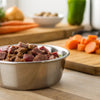How to Transition to Raw Dog Food: A Comprehensive Guide for Pet Owners
- Houndsy
Table of Contents
- Introduction
- The Benefits of Transitioning to Raw Dog Food
- How to Switch Your Dog to Raw Food: Simple Steps
- What to Expect When Switching to Raw
- Which is the Best Raw Food to Choose?
- Common Questions About the Raw Feeding Transition
- Conclusion
- FAQ Section
Introduction
Did you know that a staggering 32% of dog owners prioritize health and wellness when selecting their pet's food? Recently, a study by Mintel found that nearly half of pet parents prefer giving their dogs a diet more closely resembling what they would eat in the wild. This growing awareness reflects a significant shift towards more natural feeding practices, with raw diets taking the spotlight. Transitioning to a raw dog food diet may seem daunting, but it's a rewarding change that can enhance your dog’s overall health and vitality.
In this blog post, we will explore how to transition to a raw dog food diet effectively, minimize potential challenges, and help your pet enjoy their new meals. We'll share insights into why a raw diet can be beneficial, provide a detailed step-by-step guide for transitioning, and address common questions from pet owners.
By the end of this article, you'll have all the information you need to navigate this transition confidently. At Houndsy, we believe that every pet deserves a diet that supports their well-being and enhances their daily life, and embracing raw feeding may be one way to do just that.
The Benefits of Transitioning to Raw Dog Food
Before we delve into the process of switching your dog to a raw diet, let's discuss why many pet owners are making this change. Raw dog food diets often emphasize whole, unprocessed ingredients, which boast numerous benefits for your furry friends:
-
Improved Digestion: Raw diets typically contain higher moisture levels and are rich in digestible proteins, which can lead to better digestive health. Many pet owners report firmer stools with less volume, as raw food is more efficiently processed by dogs’ systems.
-
Enhanced Energy Levels: A diet rich in whole foods promotes vitality. Many dog owners notice their pets are more active and alert after transitioning away from kibble.
-
Healthier Skin and Coat: Raw diets can improve the condition of your dog’s skin and coat, reducing issues like dryness or irritation. This change is often attributed to the omega fatty acids found in raw meats.
-
Improved Dental Health: Chewing raw meaty bones can help reduce plaque and tartar build-up, promoting healthier teeth and gums.
-
Weight Management: A raw diet's higher protein content can promote lean muscle mass while providing fewer empty calories compared to highly processed kibble.
These benefits highlight why pet owners are increasingly curious about how to transition their dogs to a raw food diet. As we progress, let’s learn how to make this transition smoothly and positively.
How to Switch Your Dog to Raw Food: Simple Steps
Transitioning to raw dog food is best approached with care and patience. Here’s a simple, effective guide on how to transition to a raw dog food diet over the course of a week.
1. Understand Your Dog’s Needs
Prior to starting, it's pivotal to understand your dog's dietary needs based on their size, age, and activity level. Be sure to consult with your veterinarian, particularly if your dog has any existing health issues.
2. Prepare for Transition
Gather all necessary supplies before beginning:
- High-quality raw ingredients, including meats, organs, and bones.
- The Houndsy Kibble Dispenser, which allows for perfect portion control and keeps your raw ingredients fresh and accessible.
- Storage containers for easy meal preparation.
3. Gradual Transition Over 7 Days
A gradual transition is critical to prevent digestive upset. Here’s a breakdown of the daily switch:
-
Days 1-2: Serve 75% of your dog’s current food and 25% raw food.
-
Days 3-4: Adjust to 50% of each type of food.
-
Days 5-6: Increase to 25% current food and 75% raw food.
-
Day 7: Serve 100% raw food.
By easing the transition, you’ll give your dog’s digestive system time to adjust to the new diet.
4. Monitor Adjustments and Reactions
As you transition, keep a close eye on how your dog reacts:
-
Potential Upset Stomach: Some dogs might have temporary digestive disturbances such as gas or diarrhea during the transition. If these symptoms persist beyond a couple of days, consult your vet.
-
Adjusting Food Portion Sizes: Monitor your dog's appetite and adjust the portion sizes as necessary, especially when they move to the full raw diet.
What to Expect When Switching to Raw
During the transition, pet owners may experience a range of adjustments in their dog’s behavior and health. Here are some common observations:
-
Potential Digestive Minor Upsets: As previously mentioned, some dogs may need time to acclimate. It’s common for dogs to experience minor digestive issues such as soft stools.
-
Increased Thirst: Raw food often has a higher moisture content, so your dog may drink less water once they adapt.
-
Changes in Energy Levels: After adjusting, you might notice your dog becoming more energetic and active due to the more nutritious diet.
-
Altered Symptoms of Hunger: Initially, your dog might seem hungrier, as high-quality raw food tends to be more nutrient-dense. Over time, their hunger should stabilize.
Transitioning Tips
To support your transition, consider these helpful strategies:
-
Introduce a Familiar Protein: Starting with a protein your dog enjoys can ease the switch.
-
Use Tasty Additions: Add familiar treats to introduce the raw food flavor subtly.
-
Gradually Adjust Meal Consistency: If your dog is used to kibble, introduce raw food as a treat before integrating it fully into their diet.
By understanding these aspects, you’re setting your dog up for a successful transition to raw feeding.
Which is the Best Raw Food to Choose?
Selecting high-quality raw food is crucial for ensuring that your dog receives balanced nutrition. Here are factors to consider when choosing raw foods:
-
Complete Nutritional Balance: Ensure the raw food meals contain a balance of meats, organs, fruits, and vegetables. The Houndsy Kibble Dispenser, accessible to your pet at all times, can accommodate your choice of raw foods easily while maintaining freshness.
-
Protein Variety: Offering different protein sources not only keeps your dog's meals exciting but also aids in preventing food sensitivities.
-
Trusted Brands: Look for reputable brands that prioritize sourcing and processing quality. It's crucial to choose providers that have protocols in place for safety and quality assurance.
-
Raw Food Mixes: You may also consider premade raw mixes, which can simplify the preparation process while providing comprehensive nutrition.
Supporting your dog with a balanced diet that covers their nutritional needs is pivotal during this exciting transition.
Common Questions About the Raw Feeding Transition
Can I mix raw food and kibble?
Mixing raw food with kibble is not recommended for sensitive dogs, as it could potentially cause digestive upset. We suggest feeding kibble and raw meals at separate times to help your dog’s stomach accommodate each type.
Can raw dog food be fed to puppies and senior dogs?
Absolutely! A raw diet can be suitable for dogs of all life stages, including puppies and seniors. Ensure you adjust the nutritional content as necessary, particularly for puppies who are growing.
How much raw food should I feed my dog?
A general guideline involves feeding 2-3% of your dog’s body weight in raw food daily. However, it's essential to adapt this based on activity levels and overall health.
What should I do if my dog is a picky eater?
If your dog is hesitant about trying raw food, it may help to mix in a familiar treat or topper to entice them.
How can I make sure the transition is successful?
Patience and observation are vital. Monitor your dog’s reactions, adjust portions as needed, and consult your veterinarian if issues arise. Remember, every dog is unique, and the transition can vary based on individual preferences and sensitivities.
Conclusion
Transitioning your dog to a raw food diet can feel overwhelming, but with the right knowledge and approach, it can become a rewarding experience for both you and your furry friend. By following the gradual transition steps outlined above, monitoring responses, and selecting high-quality raw food options, you can enhance your pet’s nutrition and well-being.
At Houndsy, we not only believe in the importance of a nutritious diet but also strive to enhance the feeding experience itself. Our Houndsy Kibble Dispenser offers convenience, portion control, and a stylish addition to your home that complements your ethos for thoughtful pet care.
If you're ready to take the leap with your dog, we invite you to explore our Houndsy Kibble Dispenser to make your feeding experience as seamless and enjoyable as possible.
FAQ Section
1. How long does the transition to raw dog food typically take? Transitioning can take from 7 days to several weeks, depending on your dog’s comfort and adaptability.
2. What should I do if my dog shows signs of digestive upset? If your dog experiences persistent digestive issues, consult your veterinarian for advice tailored to your pet's specific needs.
3. Is it okay to change raw protein sources frequently? Yes, rotating protein sources can enhance your dog's diet and prevent developing food sensitivities.
4. What kind of raw food is best for senior dogs? Older dogs may benefit from protein that’s lower in calories but higher in nutrients. Always ensure they are receiving balanced meals that cater to their changing needs.
5. Can I prepare raw food at home or should I buy pre-made options? You can do either! Just ensure that homemade diets are balanced with all the required nutrients or rely on reputable pre-made raw food options.
By embracing the raw food transition and utilizing innovative tools like the Houndsy Kibble Dispenser, we can enhance the feeding ritual and elevate the everyday experience for pet owners and their furry family members.












